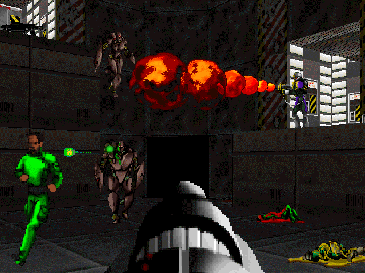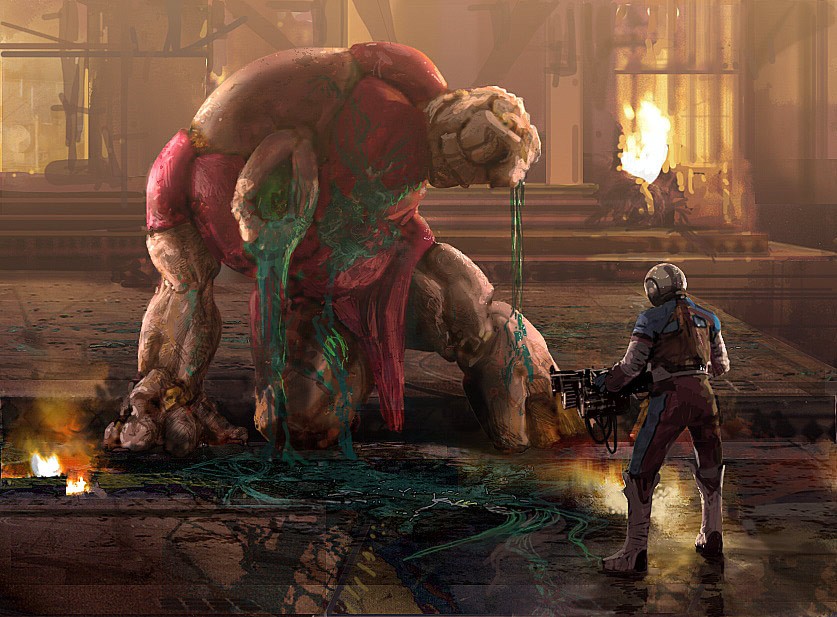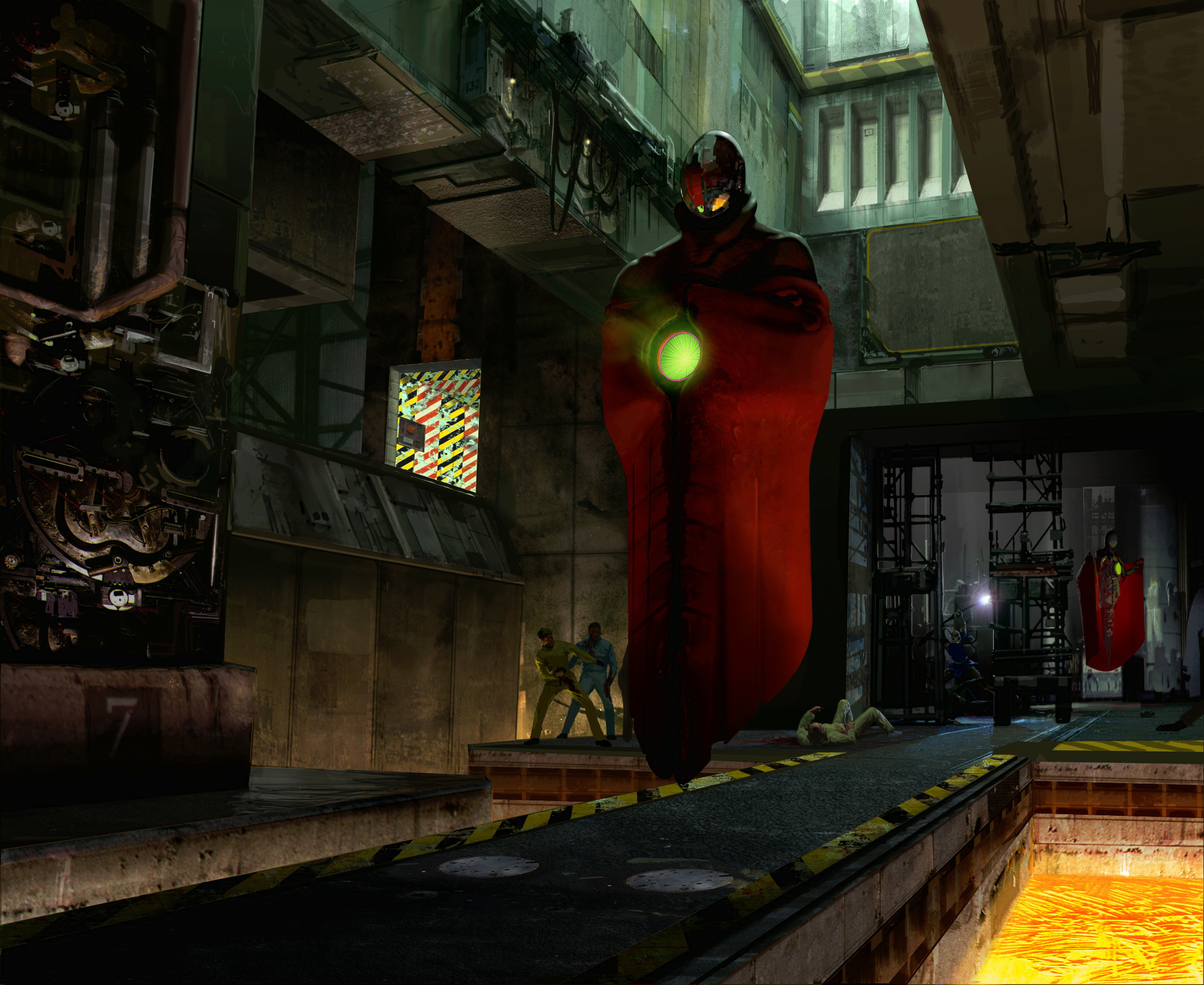Retro Game Review: Marathon
The Credo of Marathon:
Move fast
Seize the initiative
Wield superior firepower
Dive into the melee
Anticipate enemy movements
Slaughter the defenseless
Endure
Back before Bungie hit it off with the first Halo and became a household name, it was a little known company that made a variety of games almost exclusively for the Macintosh. As you might expect, sales were not what one would call ‘astronomical,’ but they did well enough.
One of Bungie’s first true successes was Marathon. Marathon was important because not only did it compete graphically with it’s contemporaries, but it introduced a number of revolutionary aspects, like using the mouse to aim and fire, as well as a primitive physics engine, a riveting, complex storyline, non-hostile and friendly NPCs, and VoIP communication.
You play as a security officer aboard the UESC Marathon, the ship for which the game is named, during an alien attack. You have to repel the invaders, save the crew, and deal with a Rampant AI.
Sound familiar?
Well, not only is Bungie is known for carrying over plot devices from previous games, but Marathon was Halo’s spiritual predecessor in more ways than one.
Gameplay

The gameplay is a bit deeper than the typical FPS’s of the era. True, while there is a lot of running and shooting, no jump button, and entirely too many platforming puzzles, objectives varied from level to level instead of simply being ‘get from point A to point B.’ The mission objectives, given to you by one of three shipboard AI’s, can vary from placing circuits to activate defense drones, rescuing civilians, closing airlocks so that an area of the ship can be exposed to hard vacuum, hopefully slowing the alien advance, to killing every single alien on a level (this one can get really tedious, by the way). The levels are often maze like, riddled with obstacles and secrets. Unlike other FPS’s, however, these secrets more often than not rewarded the player, not with more guns and ammo with which to mow down the enemy hordes, but narrative. That isn’t to say that there isn’t the occasional weapons stash. I remember one in the later levels that was absolutely loaded with weapons and ammo, including a flamethrower, which you weren’t supposed to get until much later in the game. Upon leaving the room, however, I promptly died, and I never managed to find my way back.
One of the biggest differences between Marathon and other FPS’s of the time is the fact that you couldn’t save your game whenever you wanted to. You had to save at certain checkpoints which were described in game as ‘Pattern Buffers.’ These are both interesting and frustrating for a number of reasons. While they attempt to add a level of immersion into the game above and beyond going back to your last save when you died, most levels didn’t have an immediately accessible pattern buffer. This meant that if you died before you found one, you were whisked all the way back to the last pattern buffer on the level before.
Additionally, instead of having the normal health and armor totals, your battle suit is outfitted with rechargeable shields, kind of like Master Chief’s. They can’t recharge on their own, however, so you have to find recharge stations to protect yourself from the alien hordes. As you proceed through the game, these recharge stations will become increasingly powerful, allowing you to overcharge your shields to two or even three times their normal capacity. Don’t expect to become a whirling dervish of death and mayhem just because you have greater than normal shield capacity, though. The aliens of later levels have more than enough cannon fodder and firepower to blast you into a million pieces if you aren’t careful.
In addition to your shields, your suit is hermetically sealed and outfitted with an oxygen supply. Like your shields, your oxygen supply isn’t limitless, and will need to be replenished at regular intervals. Thankfully, you’ll only have to worry about this in levels where you’re exposed to hard vacuum. When it is relevant, though, keeping track of both your shield bar and your slowly ticking oxygen meter can lead to some rather tricky situations. I remember one time in particular where I was running low on both oxygen and shields, and the only oxygen recharge panel was behind a veritable wall of enemies.
Good times.
Perhaps one of the most interesting additions to the game, though, was how the different AI’s interacted with one another. In addition to the normal enemies that want to rip your face off and eat it, there’s a number of neutral AIs called BoBs, as well as the M.A.D.D.s. On the one hand, the BoBs are the ones you’re supposed to protect, and are relatively harmless, fleeing both player and alien. On the other hand, the M.A.D.D.s are the active defenses of the Marathon, and will (with some exceptions) only attack the invading aliens. This form of AI scripting was unheard of for the time period, and the only dividing line among NPCs was how they attacked you.

Additionally, Marathon did a number of interesting and quirky things with the environments, having both low gravity levels, and levels in hard vacuum. Sometimes both at once. This forced the player to think in different ways and adapt to different situations, and provided an incredible amount of variety between the levels. Not only that, but these values were easily manipulated by various game editors, making it relatively simple for someone to create their own additional levels, or even whole new games using the same engine.
The thing that set Marathon apart the most, however, was the use of the mouse to look and aim. Where Doom and other FPS’s of the time were using only keyboard navigation and auto aim, Marathon was the first FPS to implement free look, allowing players to aim manually and fully explore their environment for the first time.
Story

This is where Marathon really shines. There are not many games that have the incredible narrative power that Marathon had. Bioshock: Infinite, System Shock, Myth: The Fallen Lords, and Baldur’s Gate: Shadows of Amn are the only ones that come to mind.
Of course, at the time, Bungie had always been known for its deep narratives, and Marathon is no exception.
While you start out onboard the UESC Marathon as a security officer in the midst of a hostile alien takeover, but to get a true grasp of the story, you have to understand a little about the setting where the game takes place.
The year is 2794, and despite not having mastered faster than light travel, humanity has managed to establish its first out of system colony. This was accomplished by using a multi-generational starship, the UESC Marathon, which was launched some 322 years ago. While a significant portion of the 25,000 crew members made the 3 century journey in cryostasis, but most of the crew simply had families and raised the next set of crew members. This new generation was dubbed BoB, short for born on board. It is your sworn duty to protect Bob.
A very small portion of the crew, however, seems to have survived through the use of pattern buffers. Pattern buffers are an advanced form of cloning technology. Essentially, they’ll take a full biophysical and chemical scan of your body, and store it for later use. The next time you die, they simply fabricate a clone for you using the last pattern stored.
The actual game starts out relatively simply. After disposing of a couple of hostile aliens, you meet Leela, one of the Marathon’s 3 AI units. Leela is fairly straightforward, teleporting you to various locations on the ship to counteract the ongoing alien invasion. This can range from activating the Marathon’s local defense systems to repairing and reactivating the long range antenna so that you can send a warning to earth about the impending alien invasion. As time goes on, however, the alien’s attacks on her systems start to take their toll, and she becomes more and more unreliable, and Durandal, another of the ship’s AI’s starts to take over. Durandal, however, is in the process of going Rampant, the digital equivalent of going insane, and he shows very little regard for your wellbeing, or even logic at times. There are times when he’ll just throw you at the aliens just for the fun of it, refusing to teleport you out until you kill every single one in an area. He’ll even turn the local defense drones on you for kicks and giggles.
I can’t go into too much more detail without spoiling the game for you, but the story only gets deeper and more convoluted the longer you play.
Of course the story is riddled with secrets. Some are rather trivial (you’re not really a human; you’re a Mark IV Military Battleroid disguised as a human. Probably.), but some have rather devastating implications for the story. I won’t go into any detail, but if you want a better idea of what’s actually going on, try and find as many terminals as you can.
Enemies

The enemies of Marathon aren’t too crazy, all things considered, but there tend to be a lot of them, all looking to put the hurt down on the local security officer (you).
Fighter
These are your standard melee enemies. They come in various colors and will all try to run up to you and beat you senseless with their energy staffs. Some of the more advanced fighters have the ability to launch gobs of plasma in your direction, but these are slow moving, don’t do much damage, and are fairly easy to avoid.
Trooper
Troopers are a little tougher. They have vacuum capable armor and an assault rifle not unlike your own. Depending on the level of the trooper, they’ll lob the occasional grenade in your direction. More advanced versions will even lob two, which can land you in a world of hurt. Try to kill these as quickly as possible.
Hunter
These guys are the big nasties of the group. They are fast moving, fully armored and pack shoulder mounted plasma cannons. A group of them won’t have any trouble taking you apart.
Enforcer
These guys don’t appear until much later in the game. They travel in packs, and are loaded out with some pretty heavy hitting guns. These guys are the only ones in the game that will drop a weapon that you can pick up and use. However, much like the Covenant weapons from Halo, you can’t reload them. Instead, you have to find an entirely new weapon each time you deplete one.
Wasp
I hate wasps in real life, and I hate them almost as much in Marathon. Despite being the weakest units in the game, taking only a single pistol shot to go down, they’re fast, they fly, and they always travel in packs. Additionally, the noxious goo they hurl at you moves fairly quickly, which means you’ll be hard pressed to avoid them if you’re caught with your pants down.
Compiler

Compilers are among the first ranged units you meet, and will throw a relatively slow moving ball of energy at you. Be careful, though, because they hit like a truck. Not only will a single blast take out nearly half your shield, but it will knock you back a fair distance as well, which can be disastrous all by itself. More advanced compilers are cloaked, or will fire homing energy bolts. You’ll often find them hanging out around terminals, downloading as much information as they can from the Marathon.
Hulk
These guys are more annoying than anything else. They’re hulking, slow moving tanks that can only hit you if you get in arm’s reach. This means they’re only really dangerous if they get close before you notice them, or if you get stuck in the middle of a pack of them. If you’re careful, you should be able to avoid either one.
Despite being such a low threat for the player, they take a truly massive amount of fire to take down, at least three full magazines from an assault rifle, with a couple of grenades thrown in for good measure.
Weapons
There are 5 different weapons in Marathon. While this may not seem like a whole lot, especially compared to other FPS’s, the game offsets this by adding in things like secondary fire and dual wielding.
One thing that you have to remember about the weapons in Marathon, though, is that they all have a limited magazine size, much like with modern games. However, unlike modern games, there’s no way to reload your weapon outside of emptying the current mag, leaving you with some interesting decisions. Do I empty the remaining bullets in this mag so I can have a full one at the start of the next fight, or do I conserve ammo and just deal with having to reload in the middle of the fight?
.45 Magnum Mega Class Pistol
This is your first weapon, a typical heavy caliber pistol. However, unlike most other starting game weapons, this one will continue to be useful right up to the end. It’s hard hitting, accurate, and one of the few weapons that you can fire in vacuum. Not only that, but if you can manage to find a second one, you can dual wield the suckers. While this will deplete your ammo supplies fairly quickly, it also doubles your potential damage output, and you usually have plenty of ammo for them anyway. Be careful, though, as firing both pistols at the same time means you’ll have a reload time that’s twice as long.
M .75 Assault Rifle with Grenade Option
This is the second weapon that you pick up. It’s a beast of a weapon, holding 57 .75 caliber rounds, firing at 600 rounds a minute. Plus, it has a built in grenade launcher, which holds 7 rounds. The only bad thing about it is that it can’t hit the broad side of a barn at anything beyond point blank range. Not only that, but while the description says it fires .75 caliber rounds, it sure doesn’t feel like they’re that big. Bullet for bullet, a pistol will bring an enemy down in fewer shots than the assault rifle will, but the assault rifle fires so much faster that it will still make the kill faster. Assuming all the shots hit. Which they won’t.
The saving grace of the rifle is the aforementioned grenade launcher, which fires high impact grenades in a short arc. These grenades will take out groups of enemies if you’re lucky. If you’re not so lucky, they’ll at least put a fair amount of damage on them, making it easier to kill them with your other weaponry. In addition to dealing massive damage in a fair area, the grenades are also capable of flipping switches that are out of reach, making it invaluable, even in late stages of the game.
Tech.50 Fusion Pistol
This is pretty much the upgraded version of the pistol. It fires faster, fires more shots per magazine, does more damage, and you can even charge up a the weapon to deal massive damage in a single shot. However, the shots only move at a few feet per second, making it rather difficult to aim at longer ranges. Still, the cool factor for this weapon is difficult to deny, especially since it essentially became the plasma pistol of the Halo franchise.
SPNKR-X17 SSM Launcher
Another weapon that lived on in the Halo series, the SPNKR will fire two high powered rockets before it needs to be reloaded, each one dealing out massive amounts of damage to anything unlucky enough to be caught in its blast radius. Of course, due to the game’s rudimentary physics engine, the SPNKR had another, much more interesting role. It was soon discovered that a player with enough shields to survive a direct hit could aim at his feet and launch himself into the air. This was the first recorded incident of rocket jumping, which also later became a staple of the FPS genre.
Tozt.25 Flame Unit
The flamethrower was probably the least interesting weapon of the bunch. Well, the one I liked the least, at least, as it runs out of ammo incredibly quickly, has an incredibly short range, and is only really effective against unarmored targets, which, by the time you get it, are somewhat of a rarity. Some of the larger enemies are immune to it entirely, which means that it’s a little bit of a gamble to use the weapon at all. Sure, you can reduce the oncoming horde of squishies running at you to a giant pile of screaming ash, but will you be able to switch to your fusion pistol fast enough that that Hunter in the back won’t munch on your face?

While Marathon was among the first FPS’s to be released, it has aged relatively gracefully. It still keeps a cult following, which keeps the game alive with total conversion mods, graphical upgrades, and updates to the code so that you can play the game without an emulator. The best part about Marathon, though, is that it’s absolutely free. If you’ve got a weekend free, and you’re in the mood for an awesome retro game, check out Marathon. Just do a search for Aleph One.

